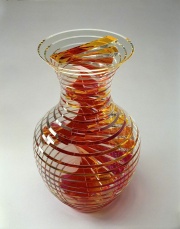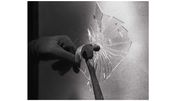Difference between revisions of "Plate glass"
m (Text replace - "== Authority ==" to "== Sources Checked for Data in Record ==") |
|||
| (5 intermediate revisions by the same user not shown) | |||
| Line 1: | Line 1: | ||
| − | [[File:1996.217-SC116538.jpg|thumb|]] | + | [[File:1996.217-SC116538.jpg|thumb|Plate Glass vase<br>MFA# 1996.217]] |
| + | [[File:plate glass photo.jpg|thumb|Photo of Hammer Breaking Plate Glass<br>MFA# 1993.999.8]] | ||
== Description == | == Description == | ||
| − | A strong, transparent sheet of glass that has very few, if any, distortions. Plate glass is typically composed of white [[sand]], [[sodium carbonate]], [[limestone]], [[alumina]], [[manganese dioxide]], and [[cullet]]. It was mass produced by the Chance process introduced in the 1830s. The liquid glass was cast onto an iron table, then | + | A strong, transparent sheet of glass that has very few, if any, distortions. Plate glass is typically composed of white [[sand]], [[sodium carbonate]], [[limestone]], [[alumina]], [[manganese dioxide]], and [[cullet]]. It was mass produced by the Chance process introduced in the 1830s. The liquid glass was cast onto an iron table, then rolled to a desired thickness. The large sheets were cooled slowly, then ground and polished to produce a smooth, flat sheet. Introduced in 1959, the [[float glass]] process was produced a continuous sheet of glass floating on a bed of molten tin. This eliminated the need for grinding and polishing and by 1993, 90% of the world's glass was made by the float process. Because plate glass is stronger than [[pressed glass]] and does not have the distortions, it was used for mirrors, windows, glass doors, store fronts, and building facades. |
See also [[insulated glass]], [[laminated glass]], and [[heat absorbing glass]]. | See also [[insulated glass]], [[laminated glass]], and [[heat absorbing glass]]. | ||
| Line 8: | Line 9: | ||
== Synonyms and Related Terms == | == Synonyms and Related Terms == | ||
| − | window glass; sheet glass; polished plate; plate-glass; verre plat (Fr.); chapa de vidro (Port.); cast glass; rolled glass; Herculite [PPG]; Solvex; Thermoplane; Tuf-Flex; Twindow | + | window glass; sheet glass; flat glass; polished plate; plate-glass; verre plat (Fr.); chapa de vidro (Port.); cast glass; rolled glass; Herculite [PPG]; Solvex; Thermoplane; Tuf-Flex; Twindow |
| − | == | + | == Physical and Chemical Properties == |
| − | Plate glass is resistant to most acids, except hydrofluoric and phosphoric acids. Exposure to alkaline solution can damage glass. | + | * Plate glass is resistant to most acids, except hydrofluoric and phosphoric acids. |
| + | * Exposure to alkaline solution can damage glass. | ||
| − | == | + | == Resources and Citations == |
| − | |||
| − | |||
| − | |||
| − | |||
| + | * K.Konrad, K. Wilson, W. Nugent, F.Calabrese, "Plate Glass", in ''Twentieth-Century Building Materials'', T. Jester (ed.), McGraw-Hill: New York, 1995. | ||
* Thomas C. Jester (ed.), ''Twentieth-Century Building Materials'', McGraw-Hill Companies, Washington DC, 1995 Comment: K.Konrad, K. Wilson, W. Nugent, F.Calabrese, "Plate Glass" | * Thomas C. Jester (ed.), ''Twentieth-Century Building Materials'', McGraw-Hill Companies, Washington DC, 1995 Comment: K.Konrad, K. Wilson, W. Nugent, F.Calabrese, "Plate Glass" | ||
| − | |||
* Edward Reich, Carlton J. Siegler, ''Consumer Goods: How to Know and Use Them'', American Book Company, New York City, 1937 | * Edward Reich, Carlton J. Siegler, ''Consumer Goods: How to Know and Use Them'', American Book Company, New York City, 1937 | ||
| − | |||
* ''Dictionary of Building Preservation'', Ward Bucher, ed., John Wiley & Sons, Inc., New York City, 1996 | * ''Dictionary of Building Preservation'', Ward Bucher, ed., John Wiley & Sons, Inc., New York City, 1996 | ||
| − | |||
* Random House, ''Webster's Encyclopedic Unabridged Dictionary of the English Language'', Grammercy Book, New York, 1997 | * Random House, ''Webster's Encyclopedic Unabridged Dictionary of the English Language'', Grammercy Book, New York, 1997 | ||
| − | |||
* ''The American Heritage Dictionary'' or ''Encarta'', via Microsoft Bookshelf 98, Microsoft Corp., 1998 | * ''The American Heritage Dictionary'' or ''Encarta'', via Microsoft Bookshelf 98, Microsoft Corp., 1998 | ||
| − | |||
* G.S.Brady, ''Materials Handbook'', McGraw-Hill Book Co., New York, 1971 Comment: p. 616 | * G.S.Brady, ''Materials Handbook'', McGraw-Hill Book Co., New York, 1971 Comment: p. 616 | ||
| − | + | * Wikipedia: [https://en.wikipedia.org/wiki/Plate_glass Plate glass] Accessed March 2025 | |
[[Category:Materials database]] | [[Category:Materials database]] | ||
Latest revision as of 09:39, 17 March 2025
Description
A strong, transparent sheet of glass that has very few, if any, distortions. Plate glass is typically composed of white Sand, Sodium carbonate, Limestone, Alumina, Manganese dioxide, and Cullet. It was mass produced by the Chance process introduced in the 1830s. The liquid glass was cast onto an iron table, then rolled to a desired thickness. The large sheets were cooled slowly, then ground and polished to produce a smooth, flat sheet. Introduced in 1959, the Float glass process was produced a continuous sheet of glass floating on a bed of molten tin. This eliminated the need for grinding and polishing and by 1993, 90% of the world's glass was made by the float process. Because plate glass is stronger than Pressed glass and does not have the distortions, it was used for mirrors, windows, glass doors, store fronts, and building facades.
See also Insulated glass, Laminated glass, and Heat absorbing glass.
Synonyms and Related Terms
window glass; sheet glass; flat glass; polished plate; plate-glass; verre plat (Fr.); chapa de vidro (Port.); cast glass; rolled glass; Herculite [PPG]; Solvex; Thermoplane; Tuf-Flex; Twindow
Physical and Chemical Properties
- Plate glass is resistant to most acids, except hydrofluoric and phosphoric acids.
- Exposure to alkaline solution can damage glass.
Resources and Citations
- K.Konrad, K. Wilson, W. Nugent, F.Calabrese, "Plate Glass", in Twentieth-Century Building Materials, T. Jester (ed.), McGraw-Hill: New York, 1995.
- Thomas C. Jester (ed.), Twentieth-Century Building Materials, McGraw-Hill Companies, Washington DC, 1995 Comment: K.Konrad, K. Wilson, W. Nugent, F.Calabrese, "Plate Glass"
- Edward Reich, Carlton J. Siegler, Consumer Goods: How to Know and Use Them, American Book Company, New York City, 1937
- Dictionary of Building Preservation, Ward Bucher, ed., John Wiley & Sons, Inc., New York City, 1996
- Random House, Webster's Encyclopedic Unabridged Dictionary of the English Language, Grammercy Book, New York, 1997
- The American Heritage Dictionary or Encarta, via Microsoft Bookshelf 98, Microsoft Corp., 1998
- G.S.Brady, Materials Handbook, McGraw-Hill Book Co., New York, 1971 Comment: p. 616
- Wikipedia: Plate glass Accessed March 2025

